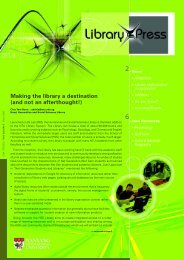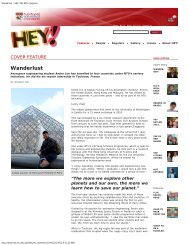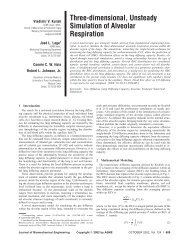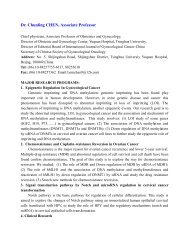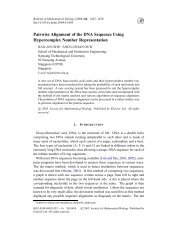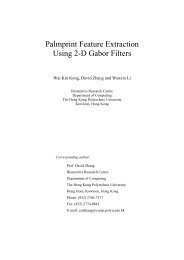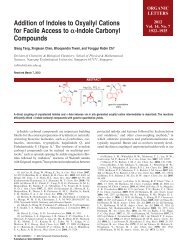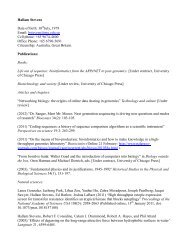Emotional reactions to scandals: When does moral character make ...
Emotional reactions to scandals: When does moral character make ...
Emotional reactions to scandals: When does moral character make ...
Create successful ePaper yourself
Turn your PDF publications into a flip-book with our unique Google optimized e-Paper software.
JOBNAME: No Job Name PAGE: 5 SESS: 12 OUTPUT: Wed May 4 18:23:16 2011 SUM: 82979859<br />
/v2501/blackwell/A_journals/ajsp_v0_i0/ajsp_1344<br />
1<br />
2<br />
3<br />
4<br />
5<br />
6<br />
7<br />
8<br />
9<br />
10<br />
11<br />
12<br />
13<br />
14<br />
15<br />
16<br />
17<br />
18<br />
19<br />
20<br />
21<br />
22<br />
23<br />
24<br />
25<br />
26<br />
27<br />
28<br />
29<br />
30<br />
31<br />
32<br />
33<br />
34<br />
35<br />
36<br />
37<br />
38<br />
39<br />
40<br />
41<br />
42<br />
<strong>Emotional</strong> responses <strong>to</strong> <strong>scandals</strong> 5<br />
h 2 p = 0.106 in the humble person condition. In all impression<br />
conditions, participants reported more positive and<br />
fewer negative emotions <strong>to</strong>wards Ge You when they<br />
regarded him as more representative of Chinese culture (r<br />
between 0.27 and 0.34, p < 0.001). The main effect of circulation<br />
was not significant in any of the three impression<br />
conditions: F 1.90, p 0.17. More importantly, the<br />
circulation ¥ perceived cultural representativeness interaction<br />
was significant in the <strong>moral</strong> <strong>character</strong> condition only:<br />
F(1, 172) = 5.65, p = 0.02, h 2 p = 0.032 in the <strong>moral</strong> <strong>character</strong><br />
condition; F(1, 172) = 0.07, p = 0.80 in the misunders<strong>to</strong>od<br />
condition; and F(1, 172) = 0.05, p = 0.82 in the<br />
humble person condition. 3<br />
In Figure 1, we plot the predicted value of positive (vs<br />
negative) emotional responses when cultural representativeness<br />
was one standard deviation above (below) the mean and<br />
when the scandal was widely circulated or not in the <strong>moral</strong><br />
<strong>character</strong> condition. As predicted, when the impression that<br />
Ge You valued <strong>moral</strong>ity was highlighted, the participants’<br />
emotional responses were most positive when the scandal<br />
was widely circulated and when Ge You was seen as a<br />
representative of Chinese culture. <strong>When</strong> the scandal was<br />
widely circulated, emotional responses <strong>to</strong> GeYou were more<br />
positive when he was seen as more representative of Chinese<br />
culture (r = 0.47, p < 0.001). In addition, when the perceived<br />
cultural representativeness of Ge You was relatively high<br />
(one standard deviation above the mean), emotional<br />
responses <strong>to</strong>wards Ge You were more positive when the<br />
scandal was widely circulated than when it was not, although<br />
the difference was not significant [F(1, 172) = 2.94,<br />
p = 0.09]. In summary, consistent with our hypothesis,<br />
reminding the participants of Ge You’s <strong>moral</strong> <strong>character</strong> was<br />
Figure 1 Affect balance <strong>to</strong>wards Ge You in the <strong>moral</strong><br />
value condition when the scandal was widely circulated<br />
or not, and when Ge You was perceived <strong>to</strong> be relatively<br />
representative of Chinese culture (one standard deviation<br />
above the mean) or not (one standard deviation<br />
below the mean). Higher scores on the measure indicate<br />
stronger positive and weaker negative emotions<br />
<strong>to</strong>wards Ge You. ( .... ) low circulation; (—) high<br />
circulation.<br />
more effective in alleviating negative emotions <strong>to</strong>wards him<br />
when he was seen as a cultural symbol and when the scandal<br />
was widely known than when either condition was not met.<br />
Discussion<br />
In the present study, we found support for the idea that<br />
reminding people of a scandalous individual’s <strong>moral</strong> <strong>character</strong><br />
is a particularly effective strategy for reducing negative<br />
emotions <strong>to</strong>wards the scandalous individual when the<br />
scandalous individual is seen as a cultural symbol and<br />
when the scandal has spread widely. Specifically, when<br />
the participants were reminded of Ge You’s previous<br />
public statement about his benevolent values, the participants’<br />
emotional responses were most positive when the<br />
scandal was widely circulated and when he was seen as a<br />
symbol of Chinese culture. This pattern of result is consistent<br />
with the idea that a widely-circulated scandal that<br />
involves a cultural representative can evoke negative emotional<br />
<strong>reactions</strong> <strong>to</strong>wards the cultural representative.<br />
However, these emotional <strong>reactions</strong> can be alleviated if<br />
the public still has confidence in the cultural representative’s<br />
<strong>moral</strong> <strong>character</strong>.<br />
The believability manipulation did not moderate the predicted<br />
three-way interaction. In fact, this manipulation did<br />
not have any effect on the emotional responses <strong>to</strong>wards Ge<br />
You. This finding suggests that emotional responses<br />
<strong>to</strong>wards a scandalous cultural representative are driven<br />
more by whether the scandal has become public knowledge<br />
than by its perceived truth value. This interpretation is<br />
consistent with the shared reality theory (Echterhoff,<br />
Higgins, & Groll, 2005), which posits that people: (i) construe<br />
an intersubjective reality based on shared knowledge<br />
that might or might not correspond <strong>to</strong> the actual reality; and<br />
(ii) allow the shared knowledge <strong>to</strong> predicate their own judgments<br />
and actions. The shared reality theory has shed light<br />
on the social influence process in interpersonal and small<br />
group contexts (Hausmann, Levine, & Higgins, 2008). The<br />
present study extends its relevance <strong>to</strong> understanding cultural<br />
processes.<br />
Because we used a real scandal in the present investigation,<br />
our results can be generalized <strong>to</strong> emotional <strong>reactions</strong><br />
<strong>to</strong> real (vs hypothetical) <strong>scandals</strong>. However, this research<br />
strategy has a drawback: because some participants had<br />
prior knowledge of the scandal, they might also possess<br />
strong prior attitudes <strong>to</strong>wards Ge You’s involvement in the<br />
scandal. This is not a serious concern, because such prior<br />
knowledge works against our hypothesis; it should wash<br />
out the effects of our subtle experimental manipulations.<br />
Moreover, our results show that prior knowledge of the<br />
scandal did not alter our results. 3 To rule out prior knowledge<br />
of a scandal as a confounding fac<strong>to</strong>r, we sought <strong>to</strong><br />
replicate our major findings with a sample that had no prior<br />
knowledge of the scandal in the next study.<br />
© 2011 The Authors<br />
Asian Journal of Social Psychology © 2011 Blackwell Publishing Asia Pty Ltd with the Asian Association of Social Psychology and<br />
the Japanese Group Dynamics Association<br />
43<br />
44<br />
45<br />
46<br />
47<br />
48<br />
49<br />
50<br />
51<br />
52<br />
53<br />
54<br />
55<br />
56<br />
57<br />
58<br />
59<br />
60<br />
61<br />
62<br />
63<br />
64<br />
65<br />
66<br />
67<br />
68<br />
69<br />
70<br />
71<br />
72<br />
73<br />
74<br />
75<br />
76<br />
77<br />
78<br />
79<br />
80<br />
81<br />
82<br />
83<br />
84<br />
85<br />
86<br />
87<br />
88<br />
89<br />
90<br />
91<br />
92<br />
93<br />
94<br />
95



